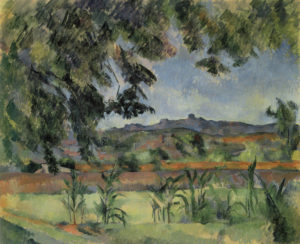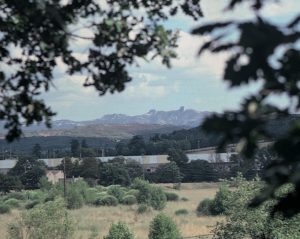R605 – Le Pilon du Roi, 1887-1888 (FWN242)
Pavel Machotka
(Cliquer sur l’image pour l’agrandir)
In a Cézanne landscape one comes to expect uncommon subjects, clear resonances between well-defined objects, and an unequivocal emphasis on color harmonies. On each of these accounts Le Pilon du Roi of c. 1888 is surprisingly lyrical and conservative, affirming the lyricism all the more clearly as as it is large and finished. It is unusually free of the customary tensions, and does not suggest a struggle with problems uncovered and solved. It seems on the contrary quietly satisfactory in the manner of a seventeenth century landscape – which is not the first expression that comes to mind before a Cézanne. The comparison is not at all frivolous; it has been suggested that some of Cézanne’s compositions show an ultimate connection to Claude Lorrain, through the example of Granet, and certainly this landscape is particularly Claudian. In it Cézanne frames the object of his interest in foliage, and the object itself is unusual: it is a profile. Apart from the contour of the Sainte-Victoire, and occasionally that of a house such as in La Maison de Bellevue sur la colline (R377), profiles interested him relatively little. In this case his interest may be justified by the unique range of hills on the horizon south of Aix: it is la Chaîne de l’Etoile, which separates Aix from Marseille, and its tallest outcropping is the Pilon du Roi. Cézanne’s touch is vertical in the apron of hills before the Pilon, diagonal in the framing leaves, and literally descriptive in two places: in the stalks of reeds in the foreground, and in the swirl of leaves above the Chaîne. Bur there he moves the furthest from the 17th century: it is as if the subject were no longer the Pilon, but the intimate connection between the ethereal sky and the solid leaves, depicted in thick paint, in which each contends for pre-eminence.
Source: Pavel Machotka: Cézanne: Landscape into Art
NB. : Voir aussi dans les études de localisation : Localisation de l’aquarelle Environs d’Aix



